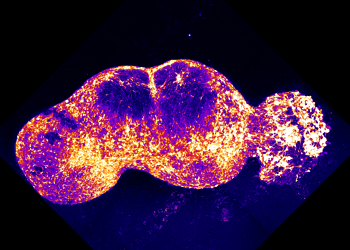Chinese researchers discovered a chemical compound that works just as well as morphine — without any of the negative side effects. The substance is derived from the venom of a centipede native to China. The discovery has huge medical applications, and could potentially reduce the country’s military reliance on morphine for battlefield use.

Image via lparchive
It’s a bit funny to be looking for painkillers in venom, isn’t it? The centipede’s secretions usually cause burning pain and swelling in the bite area without being life-threatening — but one particular chemical compound found in the venom explains Lai’s efforts. His team isolated the compound called RhTx from a complex toxin in the Chinese red-headed centipede’s chemical weapon, which has the handy ability to switch the sensation of pain on and, more usefully, off. Lai hopes to develop a painkiller based on RhTx that can be used for long-term treatments and does not compromise the user’s health.
“It is completely different from morphine,” said Professor Lai Ren who works with the Chinese Academy of Sciences’ Kunming Institute of Zoology in southern Yunnan province, and lead scientist of the study. “Morphine is only intended for emergency use. It has many side effects and can lead to addiction over the longer-term.”
Morphine has been in use by armed forces since the start of World War one, and is still the most powerful pain-relieving drug that field medics can turn to, but it’s not a miracle drug. Morphine works by depressing the central nervous system — that’s why it’s named after Morpheus, the Greek god of dreams, as it tends to cause sleepiness — and can wreak havoc on patients’ breathing and blood pressure, often to lethal effect. Another issue the drug has is that it’s addictive, big time: Being an opium derivative, it induces feelings of calm and euphoria as it interacts with our central nervous system, and most countries label it as a dangerous drug and impose drastic measures for its usage, even in medicine.

Image via pinterest
However, for all its faults, its importance as a painkiller cannot be overstated. From cancer patients to combat veterans, morphine was the only thing making life livable — some veterans with combat injuries that lead to chronic pain even resorted to taking their own lives, reports show. Lai’s team search for an alternative to painkillers such as morphine or codeine lead them to the centipede’s venom, on the logic that if a chemical can activate pain receptors, we could learn to reverse the process and get the opposite effect.
Their work lead them to centipedes. Some of the earliest known fossils date back to nearly 460 million years ago, twice as old as some dinosaurs. Pretty impressive for such small critters, and Lai suspected that the venom some species of centipede produce helped them survive through the eons. So they looked for the most aggressive, most venomous centipede they knew of, the Chinese red head, averaging in at 20 centimeters when fully grown.
“[Their bite causes] extremely sharp pain … has an instant onset and lasts from half an hour up to two to three days,” reported the research team in their paper, which was published recently in the journal Nature Communications.
It took them years of research to sift through the list of exotic chemical compounds in the critter’s venom and identify the pain related compound, RhTx. Using several observational methods, such as n-MRI and fluorescence imaging, Lai’s team found that RhTx causes a false pain alert on the victim’s central nervous system by binding to TRPV1, a heat-sensing proteins common in animals and humans.
The RhTx was able to dupe the so-called sentry protein into believing that the external temperature had suddenly shot up above its true reading, thus causing feelings of pain similar to being scalded in boiling water. But if the same compound was programmed to work in the opposite direction, the test animal could be persuaded to swim in boiling water without realizing the damage it was subjecting itself to, the team said.
The Chinese researchers said their study “opens the door for the molecular modification” of the centipede venom to reverse its effect from pain generator to painkiller.
“But there are still long roads ahead,” said Lai. “Pain is a very complex scientific issue, with lots of questions remaining about its underlying mechanisms,” he said.
“It is still too early to say whether the centipede toxin will replace morphine and become the ultimate painkiller,” Lai concluded.






